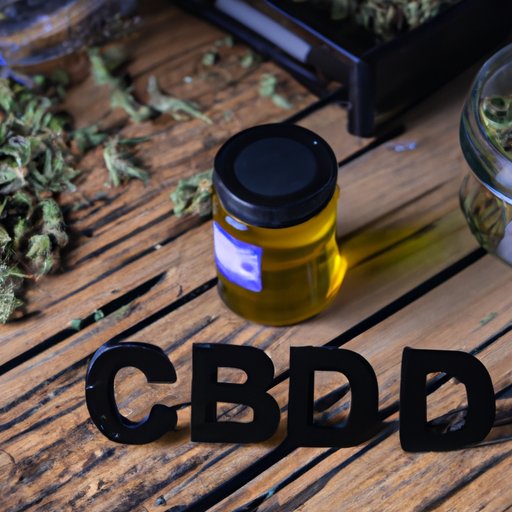Introduction
Decarboxylation is a crucial process for CBD products as it activates the therapeutic properties of cannabidiol. Without decarboxylation, CBD remains in its acidic form and doesn’t provide the same benefits. In this article, we will discuss how to decarboxylate CBD effectively and explore the benefits of this process.
Step-by-Step Guide to Decarboxylating CBD
To decarboxylate CBD, you will need an oven, baking sheet, parchment paper, thermometer, and, of course, CBD flower. The process itself is straightforward and can be broken down into a few simple steps:
1. Preheat your oven to 240°F (115°C).
2. Grind your CBD flower to increase surface area and even distribution of heat.
3. Spread the ground flower evenly on a baking sheet lined with parchment paper.
4. Place the baking sheet in the preheated oven. Set a timer for 30-40 minutes.
5. Check the temperature of the oven periodically with a thermometer to ensure that it stays at 240°F (115°C).
6. After the timer goes off, take the baking sheet out of the oven and let it cool down.
7. The decarboxylation process is now complete, and you can use the decarboxylated CBD product for recipes or other uses.
In addition to the basic steps, here are some tips to ensure the best results:
– Keep an eye on the temperature. A slight variation in temperature can affect the potency and effectiveness of decarboxylation.
– Use a grinder to ensure even distribution of heat and improved decarboxylation.
– Stir the flower once or twice during the process to ensure even heating.
– Use a high-quality CBD flower to ensure the best results.
The Importance of Decarboxylation
Decarboxylation converts CBDa, the acidic form of cannabidiol, into CBD, the active and therapeutic form. This process increases the bioavailability and effectiveness of CBD by making it more readily available for the body to absorb. Decarboxylation also helps to activate terpenes, which enhances the overall therapeutic properties of CBD.
Decarboxylation also affects the potency of CBD products. Decarboxylated CBD products have higher levels of CBD compared to non-decarboxylated ones. Therefore, it’s crucial to decarboxylate CBD products for maximum potency and effectiveness.
Comparison of Different Decarboxylation Methods
There are different ways to decarboxylate CBD, and each has its advantages and disadvantages. The most common methods are:
– Oven
– Decarboxylation machine
– Sous vide
Oven decarboxylation is the most common method, as it is accessible and straightforward. Decarboxylation machines are designed explicitly for this process and provide more precise temperature control. Sous vide is a more advanced method that involves cooking the CBD flower in a vacuum-sealed pouch at a low temperature.
Here’s a comparison of the three methods:
Oven:
– Easy and accessible
– Requires close temperature monitoring
– Limited control over temperature
– Can create a smell
Decarboxylation Machine:
– Precise temperature control
– Easy to use
– More expensive than other methods
Sous Vide:
– Most precise temperature control
– Time-consuming
– Requires more advanced equipment
Based on the comparison, the oven method is the most common and accessible method, while the decarboxylation machine offers more precise temperature control. Sous vide is a more advanced and time-consuming method that requires specialized equipment.
Recipe Ideas Using Decarboxylated CBD
Decarboxylated CBD can be used in various recipes, ranging from edibles to butter and oil. Here are some recipe ideas to get you started:
– CBD-infused brownies
– CBD-infused peanut butter cups
– CBD-infused guacamole
– CBD-infused butter for baking and cooking
To use decarboxylated CBD in recipes, it’s essential to consider the correct dosage. Start with a small amount of CBD and gradually increase it over time until you find your optimal dosage. When adding CBD to recipes, it’s important to evenly distribute it to ensure accurate dosing.
Common Mistakes to Avoid When Decarboxylating CBD
Here are some of the most common mistakes to avoid when decarboxylating CBD:
– Incorrect temperature: Ensure that the oven temperature stays consistent to avoid under or over decarboxylation.
– Incorrect timing: Over-decarboxylation can lead to loss of terpenes and reduced potency.
– Using the wrong equipment: For the best results, use an oven thermometer, baking sheet, and parchment paper.
– Uneven distribution: Uneven distribution of CBD can result in uneven decarboxylation, leading to inaccurate dosing.
To avoid these mistakes, ensure that you follow the steps and tips provided in this article. Also, invest in high-quality equipment and CBD flower to ensure the best results.
Conclusion
Decarboxylation is a crucial step for CBD products, and it’s essential to understand how to decarboxylate effectively. This guide provides step-by-step instructions, tips, and tricks for the best results. Decarboxylation improves the potency and effectiveness of CBD, which leads to a better overall experience. With the information provided in this article, you can now decarboxylate CBD products proficiently. Remember to follow the steps, avoid common mistakes, and invest in high-quality equipment and CBD flower for the best results.
For additional resources on CBD and decarboxylation, refer to reputable online sources or consult with a qualified professional.
